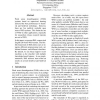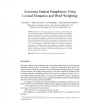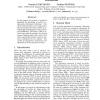301 search results - page 14 / 61 » Using Wikipedia for Automatic Word Sense Disambiguation |
ACL
2010
13 years 6 months ago
2010
Word sense disambiguation (WSD) systems based on supervised learning achieved the best performance in SensEval and SemEval workshops. However, there are few publicly available ope...
AIED
2009
Springer
14 years 2 months ago
2009
Springer
We present in this paper an approach to assessing student paraphrases in the intelligent tutoring system iSTART. The approach is based on measuring the semantic similarity between ...
CORR
2004
Springer
13 years 7 months ago
2004
Springer
This paper describes the National Research Council (NRC) Word Sense Disambiguation (WSD) system, as applied to the English Lexical Sample (ELS) task in Senseval-3. The NRC system ...
CICLING
2009
Springer
14 years 8 months ago
2009
Springer
We propose a supervised word sense disambiguation (WSD) system that uses features obtained from clustering results of word instances. Our approach is novel in that we employ semi-s...
COLING
1996
13 years 9 months ago
1996
In this paper, we propose a statistical approach for clustering of artMes using on-line dictionary definitions. One of the characteristics of our approach is that every sense of w...



